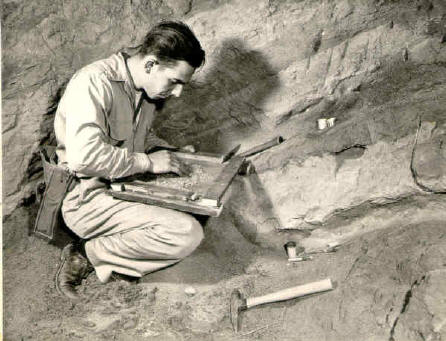|
Sixty-Eight Fossil in Eight
Hours
At the end of their workday on a Wednesday during summer vacation, the
boys were delighted to discover that they had collected sixty-eight specimens.
The variety was amazing:
Snails
Clams
Spines, fish
Femur, frog
Femur, toad
Plates, turtle
Lower teeth, horse
Upper teeth, horse
Incisor, camel |
3
3
6
1
1
6
2
3
2 |
Upper teeth, camel
Patella, camel
Metatarsal, camel
Wrist bones, camel
Molar, pocket mouse
Lower jaw, pocket gopher
(with incisor,
3 molars)
Claws, unknown
Small vertebrae, unknown
|
5
5
1
5
1
1
9
10 |
Note that the list includes invertebrates as well as fish, amphibians,
reptiles, and mammals. Of the five classes of vertebrates, only the birds are
missing. Although the nine claws had not been identified at the time of this
writing, the entire Irvington fossil collection is being restudied at the
university by Jean Firby, a graduate student. It is possible that she will
identify a small bone to be that of Tetrameryx, a 2-foot-high
antilocaprid. This fossil was found by the author at Irvington more than ten
years ago. It was studied first by Firby only recently.
 |
| Les Kent Jr, one of the
original Boy Paleontologists is at site T2 screening for rodent
bones. A new species of mouse (Peromyscus [Haplomylomys]
irvingtonensis Savage) was discovered here by this method.
The sedimentary layers (clay alternating with the fine sand) are
dipping 20 to 25 degrees toward the northeast. |
The boys found most of their fossils by screening very fine sand from a
layer only 9 inches thick. For the sifting process they used window screening.
Immediately above this layer of fine sand was a 2-foot bed of cobbles and pebbly
sand; below was an undetermined thickness of compact, fine sand. The wide
difference in the size of the sedimentary particles indicated that then, as now
streams sometimes flowed slowly and sometimes swiftly, depending on the weather.
(Swift waters mover larger sediments, such as cobbles. Sand and other fine
particles are deposited by slowly flowing streams.)
The reasons for the remarkable concentration of fossils listed are not
known. It is not surprising to find clams and snails buried with fish, frogs,
toads, and turtles. Nor is it odd to find herbivores such as horses, camels,
antilocaprids, and rodents buried together. But to find all of these in one
9-inch layer is amazing!
Can you develop two or three hypothesis concerning this matter? How was
so many kinds of animals buried together? Were they all buried at the same time,
alive? If not, how do we explain this concentration of fossils? Incidentally,
none of these small fossils seemed to have been carried very far by water. Even
under a 20-power hand magnifier, they showed no rounded or smoothed areas.
If you do attempt to reconstruct a moment in time at Irvington by using
only animals on the above list, carnivores cannot be included. This problem was
expressed by one of the boys: “A food pyramid without carnivore? Not
possible!” Was he right?
|